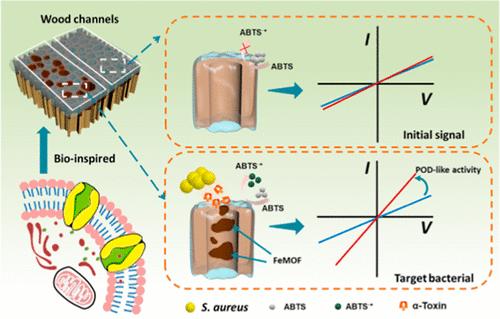当前位置:
X-MOL 学术
›
Anal. Chem.
›
论文详情
Our official English website, www.x-mol.net, welcomes your feedback! (Note: you will need to create a separate account there.)
Pore-Forming Toxin-Driven Recovery of Peroxidase-Mimicking Activity in Biomass Channels for Label-Free Electrochemical Bacteria Sensing
Analytical Chemistry ( IF 7.4 ) Pub Date : 2024-04-30 , DOI: 10.1021/acs.analchem.4c00589 Junjian Zhao 1 , Zirui Wang 1 , Mei Yang 1 , Junli Guo 1, 2 , Zhida Gao 1 , Pei Song 3 , Yan-Yan Song 1
Analytical Chemistry ( IF 7.4 ) Pub Date : 2024-04-30 , DOI: 10.1021/acs.analchem.4c00589 Junjian Zhao 1 , Zirui Wang 1 , Mei Yang 1 , Junli Guo 1, 2 , Zhida Gao 1 , Pei Song 3 , Yan-Yan Song 1
Affiliation

|
The development of sensitive, selective, and rapid methods to detect bacteria in complex media is essential to ensuring human health. Virulence factors, particularly pore-forming toxins (PFTs) secreted by pathogenic bacteria, play a crucial role in bacterial diseases and serve as indicators of disease severity. In this study, a nanochannel-based label-free electrochemical sensing platform was developed for the detection of specific pathogenic bacteria based on their secreted PFTs. In this design, wood substrate channels were functionalized with a Fe-based metal–organic framework (FeMOF) and then protected with a layer of phosphatidylcholine (PC)-based phospholipid membrane (PM) that serves as a peroxidase mimetic and a channel gatekeeper, respectively. Using Staphylococcus aureus (S. aureus) as the model bacteria, the PC-specific PFTs secreted by S. aureus perforate the PM layer. Now exposed to the FeMOF, uncharged 2,2′-azino-bis(3-ethylbenzothiazoline-6-sulfonate) (ABTS) molecules in the electrolyte undergo oxidation to cationic products (ABTS•+). The measured transmembrane ionic current indicates the presence of S. aureus and methicillin-resistant S. aureus (MRSA) with a low detection limit of 3 cfu mL–1. Besides excellent specificity, this sensing approach exhibits satisfactory performance for the detection of target bacteria in the complex media of food.
中文翻译:

生物质通道中成孔毒素驱动的过氧化物酶模拟活性恢复,用于无标记电化学细菌传感
开发灵敏、选择性和快速的方法来检测复杂介质中的细菌对于确保人类健康至关重要。毒力因子,特别是病原菌分泌的成孔毒素(PFT),在细菌性疾病中发挥着至关重要的作用,并可作为疾病严重程度的指标。在这项研究中,开发了一种基于纳米通道的无标记电化学传感平台,用于根据特定病原菌分泌的 PFT 来检测它们。在该设计中,木质基质通道采用铁基金属有机框架(FeMOF)进行功能化,然后用一层基于磷脂酰胆碱(PC)的磷脂膜(PM)进行保护,该磷脂膜(PM)充当过氧化物酶模拟物和通道看门人,分别。使用金黄色葡萄球菌 (S. aureus) 作为模型细菌,金黄色葡萄球菌分泌的 PC 特异性 PFT 可穿透 PM 层。现在暴露于 FeMOF 下,电解质中不带电荷的 2,2'-azino-bis(3-乙基苯并噻唑啉-6-磺酸盐) (ABTS) 分子会氧化成阳离子产物 (ABTS •+ )。测量的跨膜离子电流表明存在金黄色葡萄球菌和耐甲氧西林金黄色葡萄球菌(MRSA),检测限低至 3 cfu mL –1 。除了出色的特异性外,这种传感方法在检测食品复杂介质中的目标细菌方面表现出令人满意的性能。
更新日期:2024-04-30
中文翻译:

生物质通道中成孔毒素驱动的过氧化物酶模拟活性恢复,用于无标记电化学细菌传感
开发灵敏、选择性和快速的方法来检测复杂介质中的细菌对于确保人类健康至关重要。毒力因子,特别是病原菌分泌的成孔毒素(PFT),在细菌性疾病中发挥着至关重要的作用,并可作为疾病严重程度的指标。在这项研究中,开发了一种基于纳米通道的无标记电化学传感平台,用于根据特定病原菌分泌的 PFT 来检测它们。在该设计中,木质基质通道采用铁基金属有机框架(FeMOF)进行功能化,然后用一层基于磷脂酰胆碱(PC)的磷脂膜(PM)进行保护,该磷脂膜(PM)充当过氧化物酶模拟物和通道看门人,分别。使用金黄色葡萄球菌 (S. aureus) 作为模型细菌,金黄色葡萄球菌分泌的 PC 特异性 PFT 可穿透 PM 层。现在暴露于 FeMOF 下,电解质中不带电荷的 2,2'-azino-bis(3-乙基苯并噻唑啉-6-磺酸盐) (ABTS) 分子会氧化成阳离子产物 (ABTS •+ )。测量的跨膜离子电流表明存在金黄色葡萄球菌和耐甲氧西林金黄色葡萄球菌(MRSA),检测限低至 3 cfu mL –1 。除了出色的特异性外,这种传感方法在检测食品复杂介质中的目标细菌方面表现出令人满意的性能。






























 京公网安备 11010802027423号
京公网安备 11010802027423号